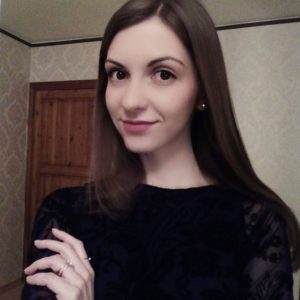Uninstall PadCrypt virus (Nov 2016 updated)
PadCrypt virus Removal Guide
Description of PadCrypt ransomware
Analysis of the PadCrypt ransomware
PadCrypt virus is another file-encrypting virus that targets various file formats and encrypts them using a sophisticated algorithm. Following the successful encryption process, malware drops a ransom note where explains victims the necessity to pay the ransom within 96 hours. According to the cyber criminals, it’s the only possibility to get back access to the corrupted files, and if victims did not meet the deadline, the necessary decryption key would be destroyed as well as their data recovery possibility. However, this threat may seem logical because PadCrypt ransomware deletes Volume Shadow Copies that might be used to recover the most important files. However, we do not believe that paying the ransom is an option because there are other data recovery methods. Keep in mind that hackers do not give you any guarantee to recover your files, so they might disappear and use your transferred money for developing new ransomware projects. Therefore, we recommend initiating PadCrypt removal. It would not decrypt your files, but protects your PC and files from other malware attacks. For ransomware elimination, you have to install or update a reliable antivirus or anti-malware application and run a full system scan. If you cannot decide which programs to choose, take our advice and use FortectIntego or SpyHunter 5Combo Cleaner.
PadCrypt ransomware spreads via malicious email attachments and infiltrates the system when the victim opens safely looking PDF file. After the installation, it starts data encryption and corrupts all files using an AES-265 algorithm. Besides, all affected files have .padcrypt file extension, so users cannot open or use them. When all files are locked, the PadCrypt virus drops a ransom on affected computer’s desktop. In the IMPORTANT READ ME.txt file victims learn that they have to pay 0.8 Bitcoins via BitCoins, Ukash Voucher or Paysafecard within 96 hours. The creators of the PadCrypt malware also offers a free data recovery option. If victims contact developers after six months, they will decrypt files for free. Honestly, after so much time, malware researchers might create a free decryption tool and victims would not chat with cyber criminals. Besides, it’s not recommended to keep ransomware for so long on your PC! Remove PadCrypt as soon as it announces about its appearance.

The creators of CryptoWall virus were the first who offered customer support services on the payment website. However, PadCrypt virus offers even more sophisticated feature – live support chat. For the first time in ransomware history, victims can have a real time conversation with hackers. However, talking with cyber criminals is not recommended in any form.
Variants of PadCrypt ransomware virus
The developers of the ransomware keep updating their projects and continue their illegal activities even after the failures. As soon as PadCrypt virus has been spotted, its servers have been deactivated immediately. However soon new versions of the malware appeared. Malware researchers have discovered three 2.0 versions of the malware: PadCrypt 2.2.71.1, PadCrypt 2.2.86.1, and PadCrypt 2.2.97.0. However, these versions are not widely spread or failed to succeed, because this autumn the developers launched the third version of the ransomware.
PadCrypt 3.0 ransomware virus is the third variant of the malware that has been discovered and analysed by virus researchers on November 2016. It gets inside computers as a Trojan and pretends to be a fake Visa Credit Card generator. PadCrypt 3.0 virus targets various personal files and encodes them using an AES-256-bit algorithm. When this process is over, victims cannot access their pictures, audio, video or other documents. The only file they can open is a ransom note where criminals explain about data encryption and decryption. As we already mentioned, you should not follow hackers’ instructions. Instead of paying the ransom, remove PadCrypt 3.0 from the computer and recover lost files from data backups or use alternative recovery methods.
How can computers get infected with PadCrypt ransomware?
PadCrypt malware does not use unique distribution technique. Usually, ransomware infects computers just like any other file-encrypting virus via malicious email attachment. The malicious file looks like a regular PDF document, but actually, it is a zip file. When victims open the file, the virus gets into the system and starts doing its job. Besides, malware may get inside the system as a Trojan horse when users use Torrents and other file-sharing services, install fake software or updates. Therefore, if you want to avoid ransomware virus, you should be careful and do not spontaneously click on every attachment and link or install software from misleading ads or other sources.
How to remove PadCrypt?
For PadCrypt removal you have to use a strong malware removal utility such as FortectIntego, SpyHunter 5Combo Cleaner or Malwarebytes. Sometimes malware prevents from installing, updating or accessing anti-malware or antivirus programs, so if it happens to you, check our step-by-step guide below. When you run a full system scan, your preferred program will find and remove PadCrypt with all its malicious files. Then, you can restore your files from data backups by simply plugging in the external device from the computer and copying necessary files. If you do not have backups, check additional data recovery methods below.
Getting rid of PadCrypt virus. Follow these steps
In-depth guide for the PadCrypt elimination
Important! →
The elimination guide can appear too difficult if you are not tech-savvy. It requires some knowledge of computer processes since it includes system changes that need to be performed correctly. You need to take steps carefully and follow the guide avoiding any issues created due to improper setting changes. Automatic methods might suit you better if you find the guide too difficult.
Step 1. Launch Safe Mode with Networking
Safe Mode environment offers better results of manual virus removal
Windows 7 / Vista / XP
- Go to Start.
- Choose Shutdown, then Restart, and OK.
- When your computer boots, start pressing the F8 button (if that does not work, try F2, F12, Del, etc. – it all depends on your motherboard model) a few times until you see the Advanced Boot Options window.
- Select Safe Mode with Networking from the list.
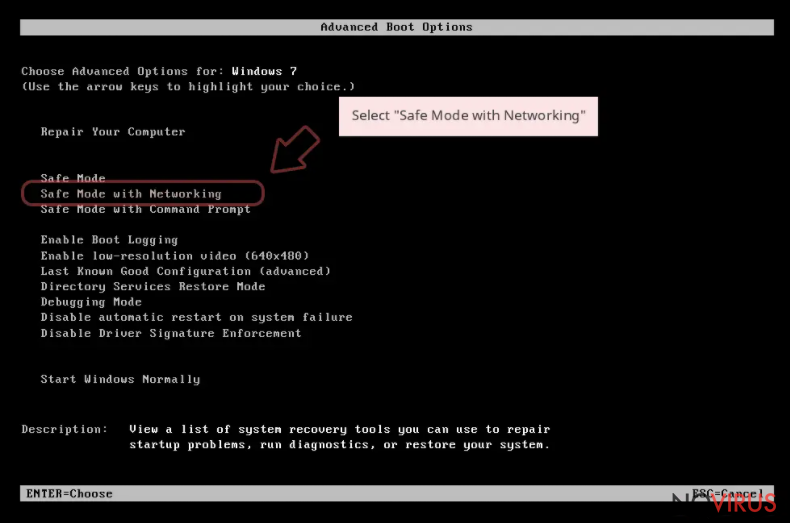
Windows 10 / Windows 8
- Right-click the Start button and choose Settings.
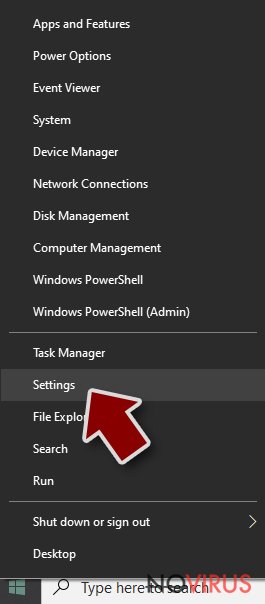
- Scroll down to find Update & Security.
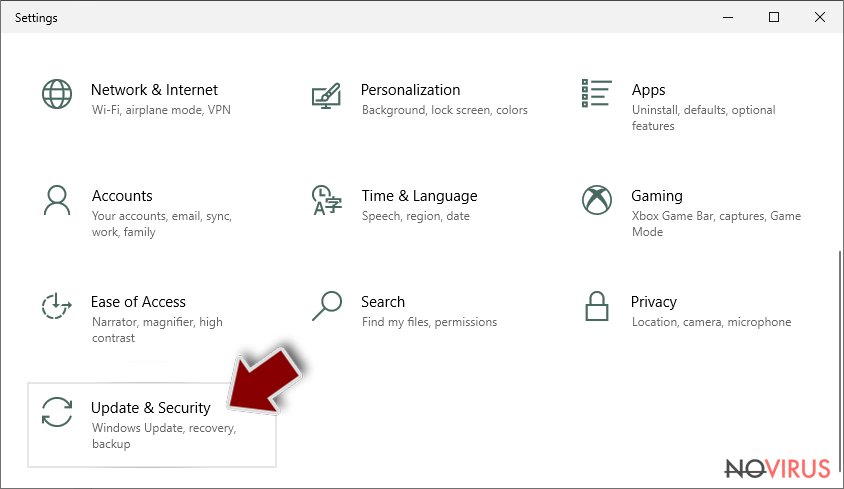
- On the left, pick Recovery.
- Scroll to find Advanced Startup section.
- Click Restart now.
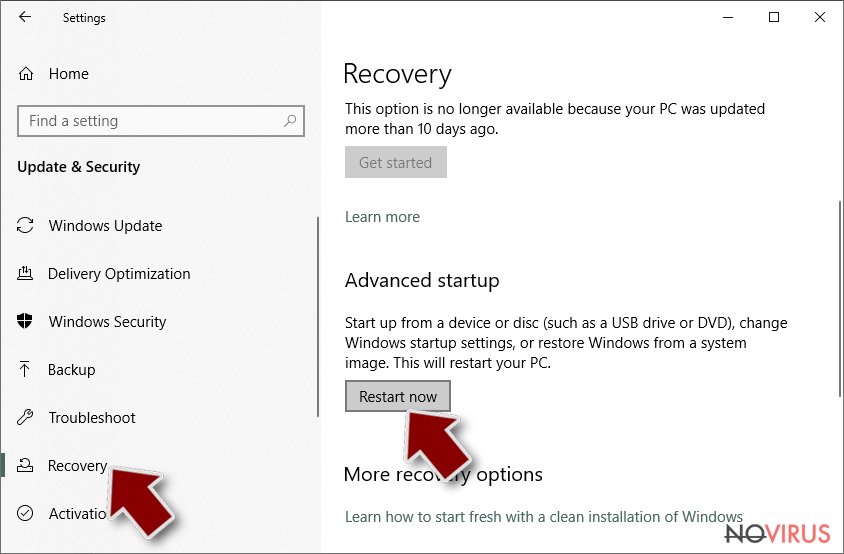
- Choose Troubleshoot.
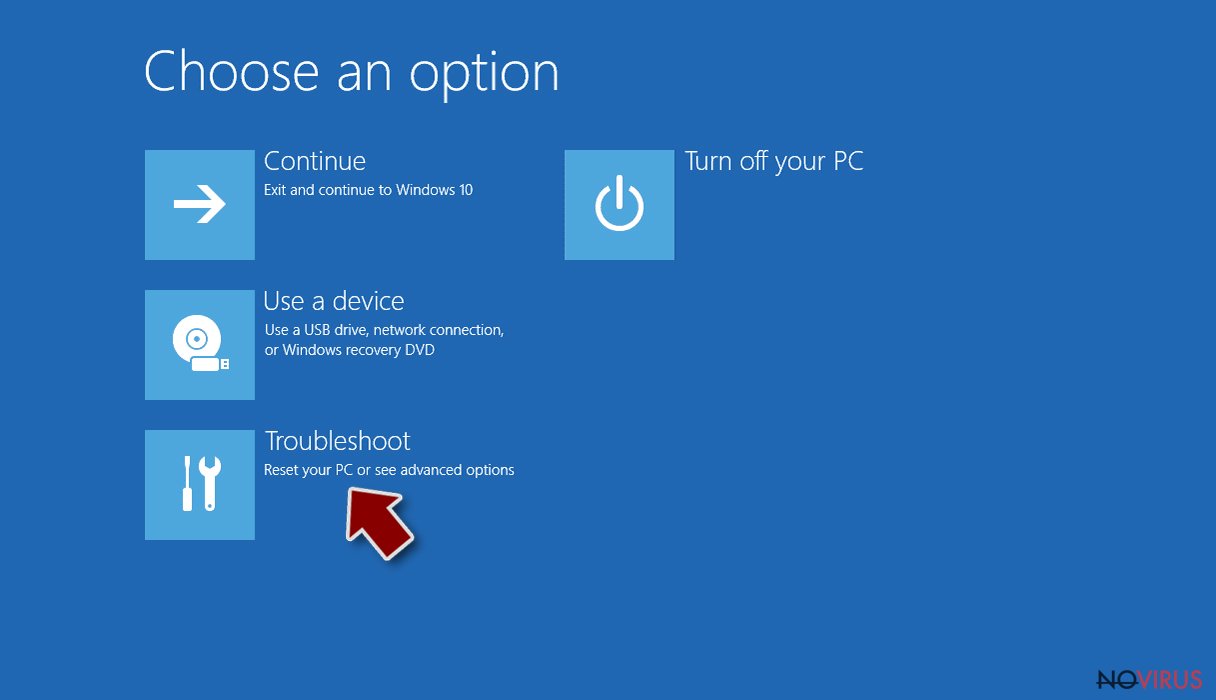
- Go to Advanced options.
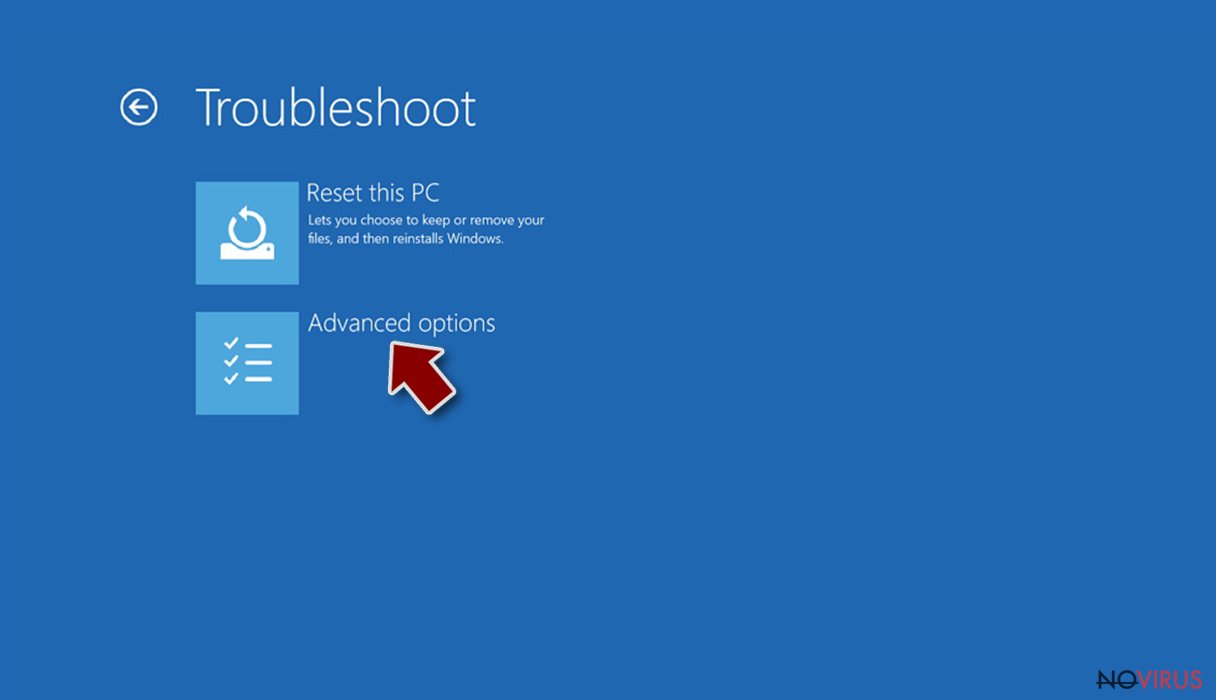
- Select Startup Settings.
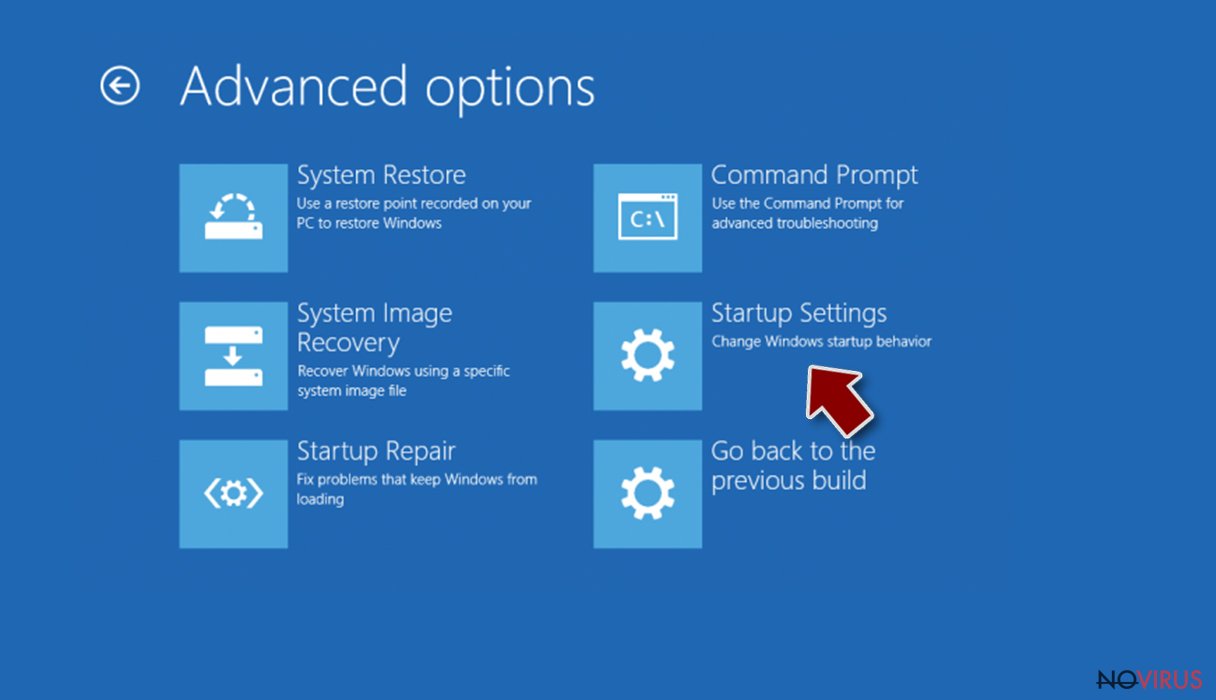
- Press Restart.
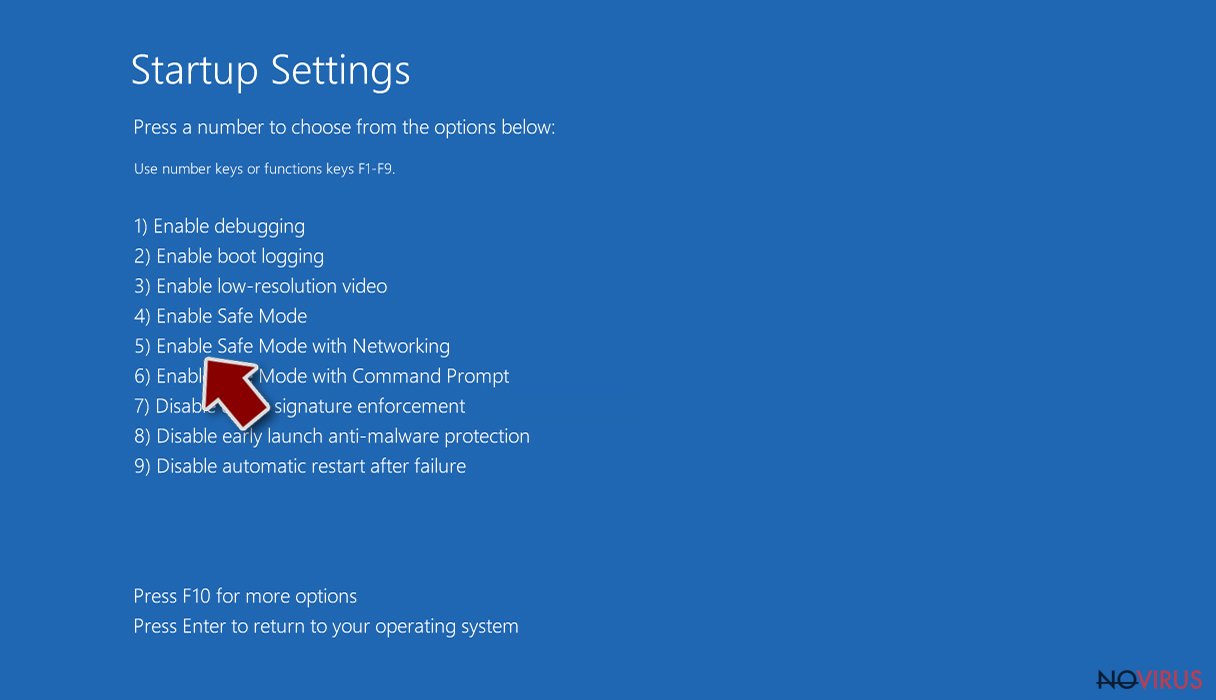
- Choose 5) Enable Safe Mode with Networking.
Step 2. End questionable processes
You can rely on Windows Task Manager that finds all the random processes in the background. When the intruder is triggering any processes, you can shut them down:
- Press Ctrl + Shift + Esc keys to open Windows Task Manager.
- Click on More details.
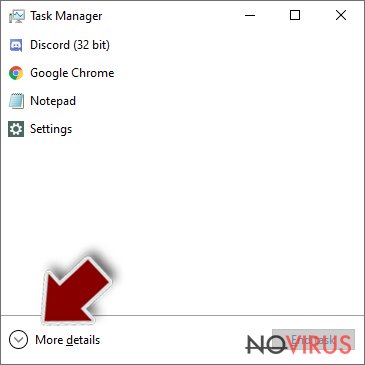
- Scroll down to Background processes.
- Look for anything suspicious.
- Right-click and select Open file location.
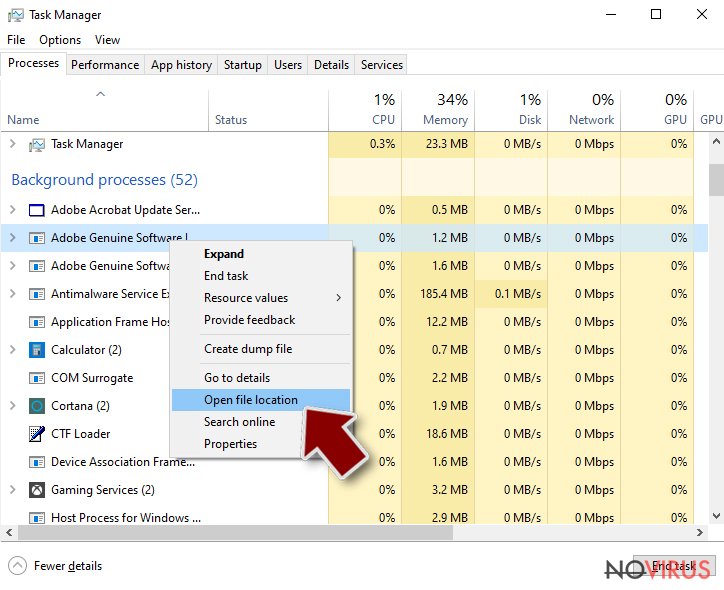
- Go back to the Process tab, right-click and pick End Task.
- Delete the contents of the malicious folder.
Step 3. Check the program in Startup
- Press Ctrl + Shift + Esc on your keyboard again.
- Go to the Startup tab.
- Right-click on the suspicious app and pick Disable.
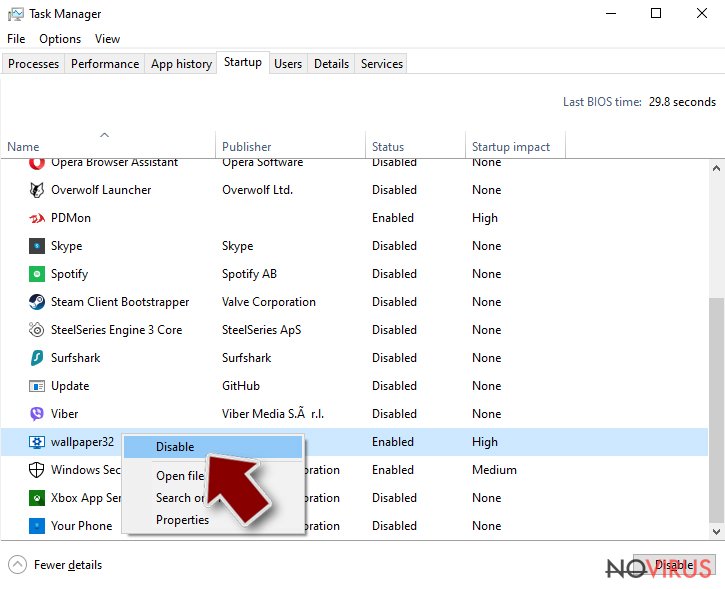
Step 4. Find and eliminate virus files
Data related to the infection can be hidden in various places. Follow the steps and you can find them:
- Type in Disk Cleanup in Windows search and press Enter.
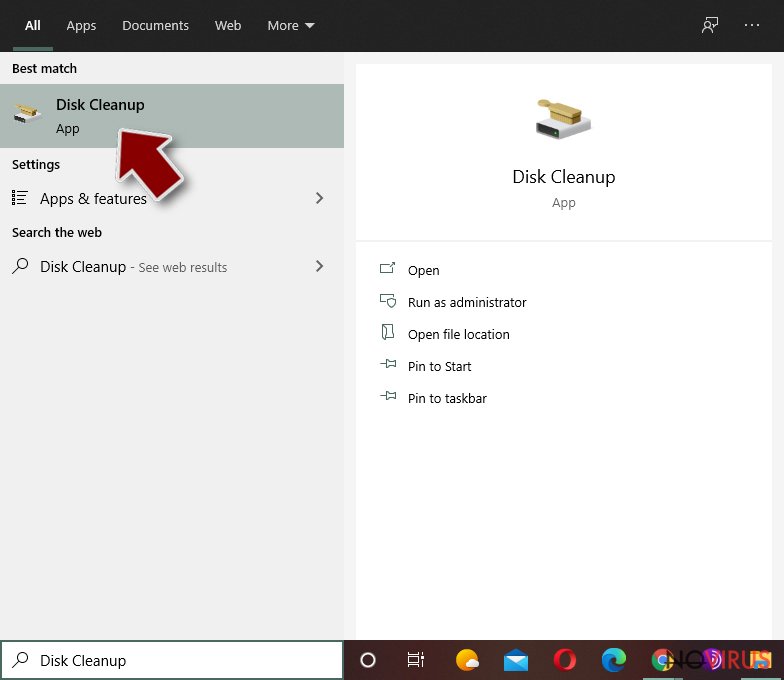
- Select the drive (C: is your main drive by default and is likely to be the one that has malicious files in) you want to clean.
- Scroll through the Files to delete and select the following:
Temporary Internet Files
Downloads
Recycle Bin
Temporary files - Pick Clean up system files.
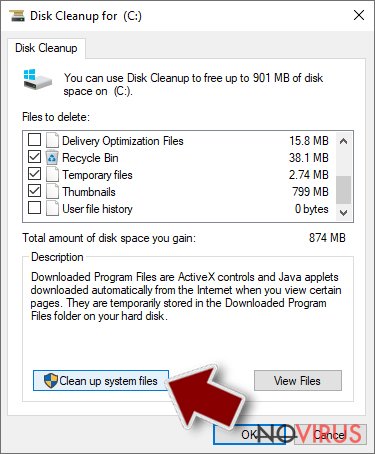
- You can also look for other malicious files hidden in the following folders (type these entries in Windows Search and press Enter):
%AppData%
%LocalAppData%
%ProgramData%
%WinDir%
After you are finished, reboot the PC in normal mode.
Eliminate PadCrypt using System Restore
-
Step 1: Restart your computer in Safe Mode with Command Prompt
Windows 7 / Vista / XP- Go to Start → Shutdown → Restart → OK.
- As soon as your computer starts, start pressing F8 key repeatedly before the Windows logo shows up.
-
Choose Command Prompt from the list

Windows 10 / Windows 8- Click on the Power button at the Windows login screen, and then press and hold Shift key on your keyboard. Then click Restart.
- Then select Troubleshoot → Advanced options → Startup Settings and click Restart.
-
Once your computer starts, select Enable Safe Mode with Command Prompt from the list of options in Startup Settings.

-
Step 2: Perform a system restore to recover files and settings
-
When the Command Prompt window appears, type in cd restore and press Enter.

-
Then type rstrui.exe and hit Enter..

-
In a new window that shows up, click the Next button and choose a restore point that was created before the infiltration of PadCrypt and then click on the Next button again.


-
To start system restore, click Yes.

-
When the Command Prompt window appears, type in cd restore and press Enter.
Bonus: Restore your files
Using the tutorial provided above you should be able to eliminate PadCrypt from the infected device. novirus.uk team has also prepared an in-depth data recovery guide which you will also find above.There are a couple of methods you can apply to recover data encrypted by PadCrypt:
Restore files with the help of Data Recovery Pro
This professional tool has been created to recover lost, deleted or encrypted files. We cannot assure that it will restore all your files, but you should definitely give it a try!
- Download Data Recovery Pro;
- Install Data Recovery on your computer following the steps indicated in the software’s Setup;
- Run the program to scan your device for the data encrypted by PadCrypt ransomware;
- Recover the data.
Wait six months
The developers of PadCrypt claims to decrypt the files for free if victims wait for six months. It’s quite a strange offers and data recovery method; however, if your files are not that important and you don’t need them right now, ou can try to do it. However, don’t forget that you should not trust and expect good things for cyber criminals.
It is strongly recommended to take precautions and secure your computer from malware attacks. To protect your PC from PadCrypt and other dangerous viruses, you should install and keep a powerful malware removal tool, for instance, FortectIntego, SpyHunter 5Combo Cleaner or Malwarebytes.
How to prevent from getting ransomware
A proper web browser and VPN tool can guarantee better safety
As online spying becomes an increasing problem, people are becoming more interested in how to protect their privacy. One way to increase your online security is to choose the most secure and private web browser. But if you want complete anonymity and security when surfing the web, you need Private Internet Access VPN service. This tool successfully reroutes traffic across different servers, so your IP address and location remain protected. It is also important that this tool is based on a strict no-log policy, so no data is collected and cannot be leaked or made available to first or third parties. If you want to feel safe on the internet, a combination of a secure web browser and a Private Internet Access VPN will help you.
Reduce the threat of viruses by backing up your data
Due to their own careless behavior, computer users can suffer various losses caused by cyber infections. Viruses can affect the functionality of the software or directly corrupt data on your system by encrypting it. These problems can disrupt the system and cause you to lose personal data permanently. There is no such threat if you have the latest backups, as you can easily recover lost data and get back to work.
It is recommended to update the backups in parallel each time the system is modified. This way, you will be able to access the latest saved data after an unexpected virus attack or system failure. By having the latest copies of important documents and projects, you will avoid serious inconveniences. File backups are especially useful if malware attacks your system unexpectedly. We recommend using the Data Recovery Pro program to restore the system.







